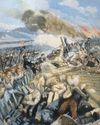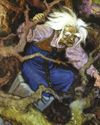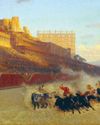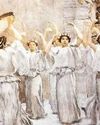Try GOLD - Free
THE FIRST AMERICANS
All About History UK
|Issue 152
Discover indigenous life before the colonists landed

SOUTHEAST
At the time of contact, or the mid-16th century, Southeastern Native American groups were organised as hierarchical chiefdoms across a large region, from east Texas to southwestern Virginia, and from southern Illinois to Florida. These groups are known to archaeologists as belonging to the Mississippian period and were first identified by their large, flat-topped earthen mounds found in abundance along the Mississippi River. However, mound sites are found across the entire region.
Chiefdoms were societies where a chief was in charge of a few hundred to a few thousand people. Corn agriculture was the basis of the Mississippian chiefdoms' society - it provided a reliable food source and could be dried, stored and exchanged for other items. These items might include engraved shell gorgets, copper repoussé plates, shell beads and finely crafted blades. The chief and his or her entourage lived on top or near the mound, and others lived in square houses located around the mound. A plaza located in front of the mound provided a place for gatherings, games, conversation, contests and more.
At the time of contact, the largest Mississippian chiefdom, Cahokia, located in present-day east St Louis, had come and gone. At its height it may have had over 20,000 residents and was engaged in trade as far away as the Southwest. Chiefdoms by their nature are unstable political organisations. Other chiefly centres rose across the region, including Etowah in northwest Georgia; Moundville in central Alabama; and Winterville and Emerald in Mississippi. Mounds contain burials of past chiefs and are sacred sites to Native American descendant groups today.
This story is from the Issue 152 edition of All About History UK.
Subscribe to Magzter GOLD to access thousands of curated premium stories, and 10,000+ magazines and newspapers.
Already a subscriber? Sign In
MORE STORIES FROM All About History UK

All About History UK
Medieval Pilgrimages
From penance to indulgence, everything you need to know about Christian holy journeys in Middle Ages Europe
9 mins
Issue 159

All About History UK
MUKDEN 1905
MUKDEN, MANCHURIA, CHINA 23 FEBRUARY - 10 MARCH 1905
11 mins
Issue 159

All About History UK
BEWARE BABA YAGA
Folklore expert Willow Winsham explains the history behind the mystery of this fearsome witch from Slavic legend
8 mins
Issue 159

All About History UK
ROYAL SCANDALS
THAT THREATENED THRONES
11 mins
Issue 159

All About History UK
DISASTER PLAN
How a lethal mixture of arrogance, fear and blind faith condemned millions of Chinese to death
10 mins
Issue 159

All About History UK
THE GODS OF NEW YORK
How a decade of turmoil shaped the Big Apple
1 mins
Issue 159

All About History UK
LOST ANCIENT SPORTS
Professor Peter J Miller discusses which ancient sporting traditions have continued into our modern world and which have been lost to time
4 mins
Issue 159

All About History UK
TERRACOTTA PANATHENAIC PRIZE AMPHORA
This ancient vase holding precious olive oil was gifted to the victors of an ancient athletic contest
1 mins
Issue 159

All About History UK
HENRY VIII HAD DIED YOUNG?
Without England's most notorious Tudor king, the country's religious and political history would've looked very different
6 mins
Issue 159

All About History UK
TITANIC MAKING AND BREAKING THE SHIP OF DREAMS
Uncover the inherent flaws and misplaced confidence that allowed a catastrophe to unfold
12 mins
Issue 159
Listen
Translate
Change font size
